Lisbon: The Night We Discovered Ginja
We continued our evening stroll once we had our fill of coffee and pastries. Naturally the sugary confections energized us to go out and explore more. We walked past Figueira Square and was happy to find a grocery store in the area. Here we stocked up on sardines (gifts for friends back home) and browsed at all the foreign merchandise. One of the joys of traveling for us is going to a grocery store and look at what the locals buy and eat. Inside there is a pasteleria off the entrance on the left side. We scanned the pastries inside the glass cabinet, our mouth watering the entire time. And all this after we just had a little snack. Unfortunately we had to wait until the long line thinned out a bit because we did not want to wait in line while on vacation. To wait out the line, we checked out the wine section, which was fortuitously located next to the pastries area. As I was reading the labels on the bottle, I spotted something I have never seen before. A ginja. I may have been talking loudly to the husband that out of nowhere a man appeared on my side asking me if I wanted to sample the liquer. Naturally I did. The guy who apparently manned the wine and spirits section of the grocery store gave us samples, talked about it and told us about the ginja house nearby which is the most famous in Lisbon. His words.
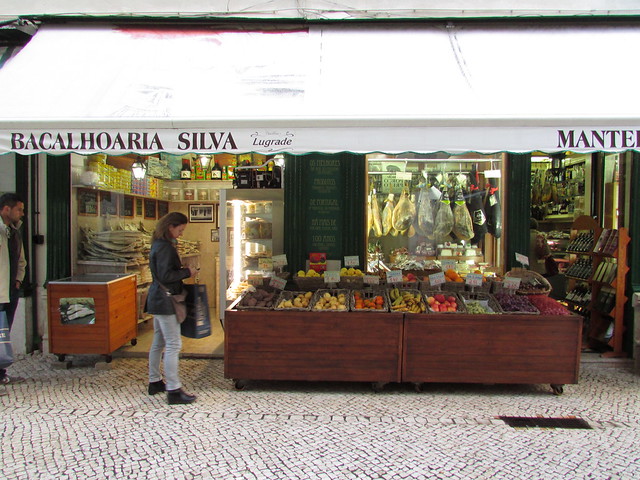
Not the grocery store.
Once we were done with our shopping we were ready to go back to the hotel and call it a night. It was a very long day after all, but we passed by a small locals only restaurant with a sign about a fish soup. Fish soup sounded just like the perfect dinner on a rainy cold night. So we went in and got soup to go.
We passed by the ginja house on the way to the hotel. Ginjinha or simply Ginja, is a portuguese liqueur made by infusing ginja berries, (sour cherry) (Prunus cerasus austera, the Morello cherry) in alcohol (aguardente is used) and adding sugar together with other ingredients. Ginjinha is served in a shot form with a piece of the fruit in the bottom of the cup. It is a favourite liqueur of many Portuguese and a typical drink in Lisbon,

The ginja house without a line. We have seen it with long lines. We waited in line for a shot of ginja. One euro per shot.
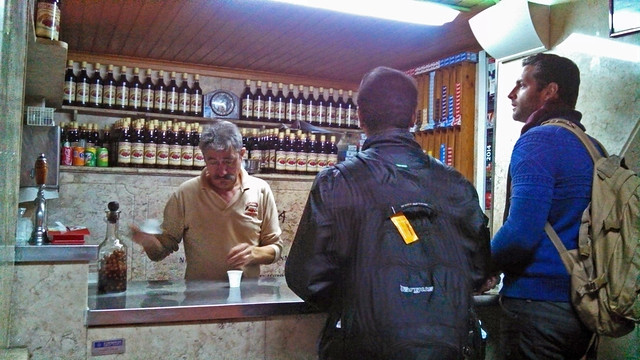
The Ginjinha of the Praça de São Domingos in Lisbon was the first establishment in that city to commercialize the drink that gives its name to it. A Galician friar of the Church of Santo António, Francisco Espinheira, had the experience of leaving ginja berries in aguardente (the Portuguese brandy), adding sugar, water and cinnamon. The success was immediate and Ginginha became the typical drink of Lisbon. In the 2000s, the business was in the hands of the fifth generation. Currently, "the Ginjinha" is an exporter for the market in the United States. The production of Ginjinha reached over 150 thousand litres per year. In many places of Portugal, especially in the Lisbon and Oeste regions, there are several producers of this traditional liqueur. In Óbidos, Ginjinha is commonly served in a small edible chocolate cup. (wiki)
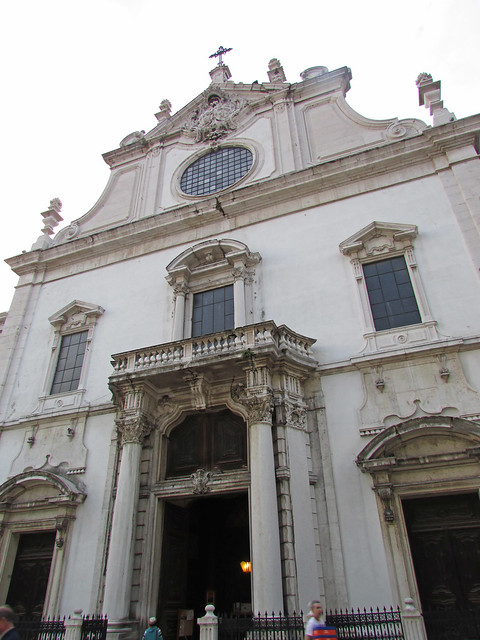
The church of Sao Domingo is located near the ginja house. We noticed it earlier but never got around to going inside until now. To the right of the National Theater, east of Rossio, is the Church of São Domingos, that is either blessed or cursed, having survived fires and earthquakes.
Prior to the Great Earthquake of 1755 this was where the São Domingos Convent stood, from which the Inquisition read out its sentences. In 1950 it was partially destroyed by a fire and has since undergone restoration, but there are still clear signs of the fire (the permeating smell and the scorched pillars).
Worthy of note is the high altar, with red marble columns that support the sculptural composition of the Holy Trinity.
Another outstanding feature is the sacristy, which for many years held the remains of King Afonso III, until they were moved to Alcobaça.
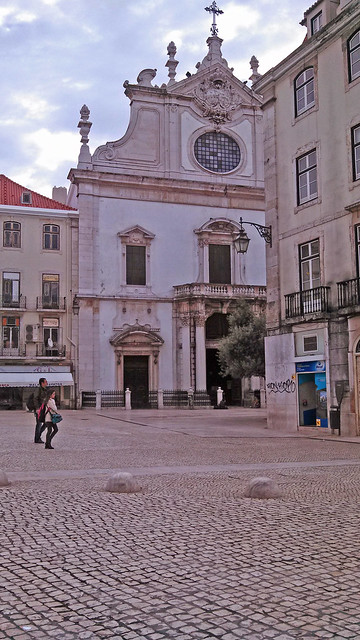
The church photographed the next morning.
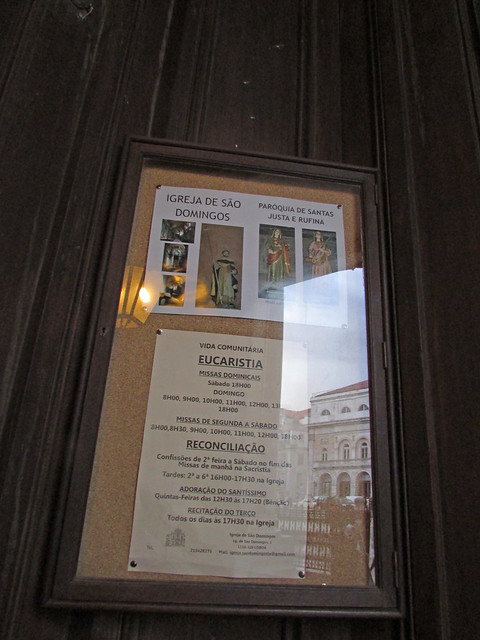
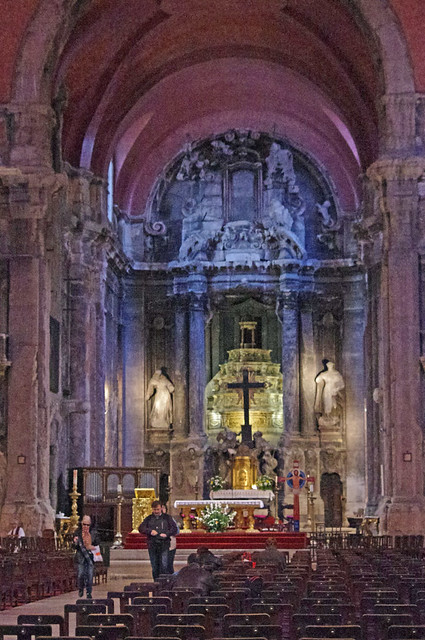
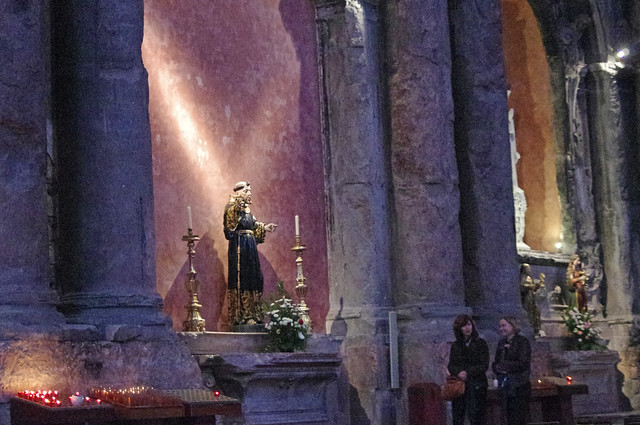

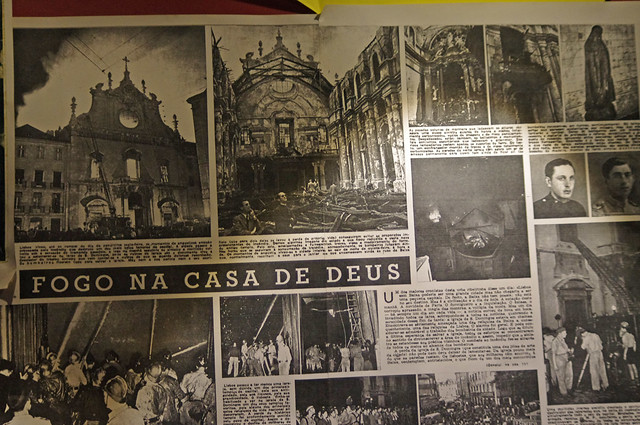
The church was dimly lit but you can still see very clearly signs of the fire.
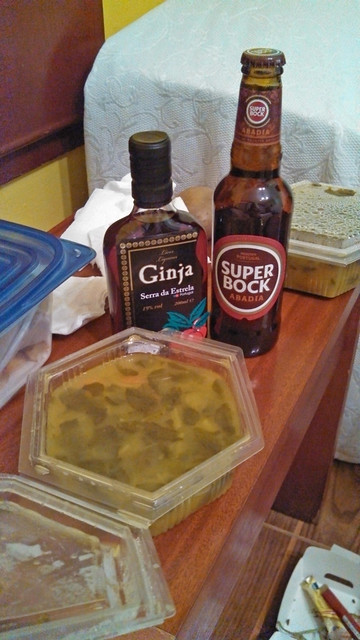
The first day ended with us having take out consisting of fish soup and some pastries with local beer and ginja.
OUR WORLD TUESDAY

Not the grocery store.
Once we were done with our shopping we were ready to go back to the hotel and call it a night. It was a very long day after all, but we passed by a small locals only restaurant with a sign about a fish soup. Fish soup sounded just like the perfect dinner on a rainy cold night. So we went in and got soup to go.
We passed by the ginja house on the way to the hotel. Ginjinha or simply Ginja, is a portuguese liqueur made by infusing ginja berries, (sour cherry) (Prunus cerasus austera, the Morello cherry) in alcohol (aguardente is used) and adding sugar together with other ingredients. Ginjinha is served in a shot form with a piece of the fruit in the bottom of the cup. It is a favourite liqueur of many Portuguese and a typical drink in Lisbon,

The ginja house without a line. We have seen it with long lines. We waited in line for a shot of ginja. One euro per shot.

The Ginjinha of the Praça de São Domingos in Lisbon was the first establishment in that city to commercialize the drink that gives its name to it. A Galician friar of the Church of Santo António, Francisco Espinheira, had the experience of leaving ginja berries in aguardente (the Portuguese brandy), adding sugar, water and cinnamon. The success was immediate and Ginginha became the typical drink of Lisbon. In the 2000s, the business was in the hands of the fifth generation. Currently, "the Ginjinha" is an exporter for the market in the United States. The production of Ginjinha reached over 150 thousand litres per year. In many places of Portugal, especially in the Lisbon and Oeste regions, there are several producers of this traditional liqueur. In Óbidos, Ginjinha is commonly served in a small edible chocolate cup. (wiki)

The church of Sao Domingo is located near the ginja house. We noticed it earlier but never got around to going inside until now. To the right of the National Theater, east of Rossio, is the Church of São Domingos, that is either blessed or cursed, having survived fires and earthquakes.
Prior to the Great Earthquake of 1755 this was where the São Domingos Convent stood, from which the Inquisition read out its sentences. In 1950 it was partially destroyed by a fire and has since undergone restoration, but there are still clear signs of the fire (the permeating smell and the scorched pillars).
Worthy of note is the high altar, with red marble columns that support the sculptural composition of the Holy Trinity.
Another outstanding feature is the sacristy, which for many years held the remains of King Afonso III, until they were moved to Alcobaça.

The church photographed the next morning.





The church was dimly lit but you can still see very clearly signs of the fire.

The first day ended with us having take out consisting of fish soup and some pastries with local beer and ginja.
OUR WORLD TUESDAY
The architecture is impressive. The church is a work of art and a testament to the beauty man can create. And it is amazing how the scorched smell survived these many years after the fire.
ReplyDeleteHello, it has been fun exploring the city of Lisbon with you through your photos. Thanks for sharing, have a happy week ahead!
ReplyDeleteJust lovely! And Ginja in those chocolate cups - delicious!
ReplyDeleteBeautiful photography and delightful post about the traditional drink ~ sounds like you are or have had a wonderful trip!
ReplyDeleteHappy Week to you ~ ^_^
What an amazing church. You've got some marvelous photos here.
ReplyDeleteNever heard of ginja before, by the way.
Thanks for sharing at http://image-in-ing.blogspot.com/2016/05/getting-ready-to-play.html
The building is impressive. I wish I could taste the drink. I'm thinking it's maybe like a liqueur.
ReplyDeleteNow I want to have a shot of ginja!
ReplyDeleteWe discovered ginja in Óbidos. We like it best in the little chocolate shot cups.
ReplyDeleteWell... I had never hears of ginjinha, but you have definitely sold it to me! Hmmmm.... Perhaps we need a long weekend in Lisbon..... :)
ReplyDeletethe church interior looks mesmerizing
ReplyDeleteYOur pics really convey the ambiance!
ReplyDeleteDo not worry about traveling to Germany with no language skills. In the tourist areas they are accustomed to speaking English and museum audio guides come in a variety of languages. Our hotel staff spoke perfect English and at the train station there is usually an English speaking counter.
ReplyDeleteLooks great - the food and drink sounds wonderful.
ReplyDeleteCheers to Ginja! Lovely pictures and narration!
ReplyDeleteI think I have not heard of Ginja before (maybe I have read about but I am not sure). I am sure my husband would like to try it. He discovered something called pacharan in Madrid. That is a liquor from the Navarra area.
ReplyDeletethe Ginja seem to be worth tasting :)
ReplyDeleteThat sounds like a really fun day! Cheers!!!
ReplyDeleteGosh I've learned something new. I love the photos though, especially the ones of the road, is that cobblestones?
ReplyDeleteNice night tour with you ! The Portuguese vine is very good, especially the Vinho verde a white wine !
ReplyDeleteNice post and and awesome clicks.
ReplyDeleteI always love your travel shots. Beautiful place to explore.
ReplyDeleteI hope I also get a chance to go to Lisbon someday. Would love to try that ginja!
ReplyDeleteInteresting city where old is gold
ReplyDeleteI must try Ginja as it sounds very interesting. The tour of the cathedral is special, and your photos are wonderful.
ReplyDeleteWhat a wonderful photos and great trip to Portugal and Lisboa!
ReplyDeleteI would love to know Portugal, because Brazil and Portugal are "brothers".
My daughter went to Porto and Coimbra and loved so much. She said that Portuguese people are very welcoming, hospitable and cheerful. And the architecture is gorgeous too.
Beautiful photos of the cathedral and Ginja sounds interesting. :)
ReplyDeleteAlexander
Alex's World! - http://alex.kakinan.com
Thanks for sharing these wonderful images of your trip to Lisbona. A very enjoyable post indeed.
ReplyDeleteMany greetings!
It's always worth finding out more about the local brew, Maria. HA! We actually like to taste local beers everywhere we go here in Europe. One would never believe there could be so many different beers...let alone all the other liguors/spirits out there. :)
ReplyDelete